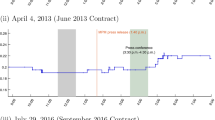Abstract
This study investigates whether different specifications of univariate GARCH models can usefully forecast volatility in the foreign exchange market. The study compares in-sample forecasts from symmetric and asymmetric GARCH models with the implied volatility derived from currency options for four dollar parities. The data set covers the period 2002 to 2012. We divide the data into two periods one for the period 2002 to 2007 which is characterised by low volatility and the other for the period 2008 to 2012 characterised by high volatility. The results of this paper reveal that the implied volatility forecasts significantly outperform the three GARCH models in both low and high volatility periods. The results strongly suggest that the foreign exchange market efficiently prices in future volatility.




Similar content being viewed by others
Notes
A symmetric model means that when a shock occurs, we will have a symmetric response of volatility to both positive and negative shocks. Asymmetric models on the other hand, allow for an asymmetric response with empirical results show that negative shocks will lead to higher volatility than a positive shock.
Over fitting happens when the statistical model describes a random error or noise instead of the underlying relationship, causing biasedness in parameter estimates.
The leverage effect is typically interpreted as a negative correlation between lagged negative returns and volatility.
As with the EGARCH the GJR-GARCH model captures the leverage effect but the way that it acts is not the same as for the EGARCH, The GJR-GARCH does not measure log returns, so in this model we still need to impose non-negative constraints.
We observe that the difference between ARCH and GARCH is the last term that makes the model less likely to break the non-negativity constraint.
If the restriction does not hold we will have non-stationarity in the variance, if α 1 + β = 1, we have a unit root in the variance.
If γ = 0, the model is symmetric. There is no need to be concerned about the conditional variance being negative since ln(σ 2 t ) is modelled.
Bollerslev et al. (2001) argue that this type of volatility is an unbiased and very efficient estimator of return volatility.
It should be noted that the parameters (α + β) were less but close to unity, suggesting that the shocks are highly persistent and die out only gradually.
It should be noted that the parameters are “forced” to be positive since we are measuring the natural log of returns. In theory, the “EGARCH benchmark model” has an AR(1) mean equation, but in our case the parameters proved to be more significant using a constant mean equation.
References
Andersen T, Bollerslev T (1998) DM-Dollar volatility: intraday activity patterns, macroeconomic announcements, and longer-run dependencies. J Financ 53(1):219–265
Andersen T, Bollerslev T, Diebold FA, Labys P (2001) The distribution of realized exchange rate volatility. J Am Stat Assoc 96(453):42–55
Andersen T, Bollerslev T, Diebold FX, Labys P (2003) Modeling and forecasting realized volatility. Econometrica 71(2):579–626
Baillie RA, Bollerslev T (1991) Intra-day and inter-market volatility in foreign exchange rates. Rev Econ Stud 58(3):565–585
Balaban E (2004) Comparative forecasting performance of symmetric and asymmetric conditional volatility models of an exchange rate. Econ Lett 83(1):99–105
Bildirici M, Ersin O (2009) Improving forecasts of GARCH family models with the artificial neural networks: an application to the daily returns in Istanbul stock exchange. Expert Syst Appl 36(4):7355–7362
Bollerslev T (1986) Generalized autoregressive conditional heteroscedasticity. J Econ 31(3):307–327
Bollerslev T (2008) A Glossary of ARCH (GARCH), Creates Research Paper, 2008–49
Broll U, Hansen-Averlant S (2010) Exchange rate volatility, international trade and labour demand. IEEP 7(4):423–36
Brownlees C, Gallo M (2010) Comparison of volatility measures: a risk management perspective. J Financ Econ 8(1):29–56
Busch T, Christensen B, Neilsen M (2012) The role of implied volatility in forecasting future realized volatility and jumps in foreign exchange, stock, and bond markets. J Econ 160(1):48–57
Chen X, Ghysels E, Wang F (2011) HYBRID GARCH models and intra-daily return periodicity. J Time Ser Econ 3(1):1–28
Donaldson R, Kamstra M (2005) Volatility forecasts, trading volume and the ARCH vs option implied volatility tradeoff. J Financ Res 27(4):519–538
Dunis C, Laws J, Chauvin S (2003) FX volatility forecasts and the informational data for volatility. Eur J Financ 17(1):117–160
Engle R, Patton A (2001) What is a good volatility model? Quant Financ 1(2):237–245
Ghysels E, Santa-Clara P, Valkanov R (2005) Predicting volatility: getting the most out of return sampled at different frequencies. J Econ 131(1):59–95
Glosten L, Jagannathan R, Runkle D (1993) On the relation between expected value and the volatility of the nominal excess return on stocks. J Financ 48(5):1779–1801
Hansen P, Lunde X (2005) A forecast comparison of volatility models: does anything beat a GARCH(1,1). J Appl Econ 20(7):873–889
Higgins M, Bera A (1992) A class of nonlinear ARCH models. Int Econ Rev 33(1):137–158
Neely C (2009) Forecasting foreign exchange volatility: why is implied volatility biased and inefficient? and does it matter? J Int Financ Mark Inst Money 19(1):188–205
Nelson (1991) ‘Conditional heteroskedasticity in asset returns: a new approach’. Econometrica 59(2):347–370
Ranaldo A (2008) Segmentation and time-of-day patterns in the foreign exchange market. J Bank Financ 33(12):2199–2206
Sentana E (1998) Quadratic ARCH Models. The Review of Economic Studies 62(4):639–661
Silvennoinen A, Terasvirta T (2008) Multivariate GARCH models. In: Andersen TG, Davis, Kreiss, Mikosch (eds) Handbook of financial time series. Springer, New York
Taylor S (1986) Modelling financial time series. Wiley, Chichester
Zakoïan J (1994) Threshold heteroskedastic models. J Econ Dyn Control 18(5):931–955
Acknowledgments
We are extremely grateful for comments and suggestions from participants at the annual European Economics and Finance Society conference 2013 in Berlin and the comments of the two anonymous referees.
Author information
Authors and Affiliations
Corresponding author
Rights and permissions
About this article
Cite this article
Pilbeam, K., Langeland, K.N. Forecasting exchange rate volatility: GARCH models versus implied volatility forecasts. Int Econ Econ Policy 12, 127–142 (2015). https://doi.org/10.1007/s10368-014-0289-4
Published:
Issue Date:
DOI: https://doi.org/10.1007/s10368-014-0289-4




